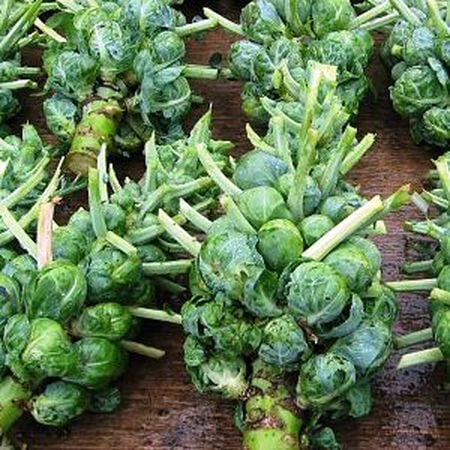Catskill, Brussels Sprout Seeds
Key Attributes
Key Attributes
Product Details
Weight
0.006Depth
0.1Height
4.5Width
3.25Plant Height
2-3'Botanical Name
Brassica oleracea var. gemmiferaSeed Type
SeedAdditional Characteristics
Freezer Friendly VegetablesSeeds Per Gram
229Seeds Per Pound
104,000Row Spacing
3'Packet
200 SeedsSow Depth
1/4"Seeds Per Ounce
6,500Breed
Open-pollinatedSun
Full SunUses
Freezer FriendlyCubic Inches
1.4625Life Cycle
AnnualSow Method
TransplantPlant Spacing
24"Categories
Brussel SproutGermination
11,12,8,9,10Days To Maturity (# Days)
100Heirloom
HeirloomSeeds Per Acre
3 lbsComponents
Growing Instructions
![]() Learning Download: How to Grow Brussels Sprouts
Learning Download: How to Grow Brussels Sprouts
Brussels sprouts belong to the Cole crop family and grow throughout a long season with a fall harvest. They can be prepared in various ways, such as roasting, boiling or eaten in thin shavings.
Before Planting: Brussels sprouts seeds are planted in the spring for a fall harvest, but they must be started indoors four weeks before the last frost date
Planting: Brussels sprouts prefer an moist, fertile soil with a pH above 6.0. 14-16 weeks before expected fall frost, sow 3 seeds every 18-24″, ¼–½” deep, in rows 30–36″ apart; when true leaves appear thin to 1 plant per location. In late spring, sow 2 seeds per cell ¼” deep. Seedlings should be ready to transplant in 4–6 weeks. Space 18–24″ between plants, in rows 30–36″ apart.
Watering: Brussels sprouts don’t mind water on their leaves, and gardeners can water the plant freely.
Fertilizer: Brussels sprouts are treated like broccoli and cauliflower and don’t require lots of additional nitrogen to grow, but do best in well-drained soil.
Days to Maturity: For the best sprouts flavor, wait until after the first fall frost to harvest, as the frost provides a sweetness to the sprouts. Sprouts are ready when their buds are green and about one to two inches in diameter. Seed individual varieties for specific maturity. (100 days)
Harvesting: After frost and until severe cold sprouts can be harvested. Pick when sprouts are firm and well formed, starting at the bottom of the stem. Break off the leaf below the sprout and snap off the sprout. The upper sprouts will continue to form and enlarge as the lower ones are harvested.
Tips: Before ground freezes, pull plants out by the roots and place in a cool cellar. Can be stored for 4-6 weeks this way.
Shipping Schedule
Our Seed Promise
 "Agriculture and seeds" provide the basis upon which our lives depend. We must protect this foundation as a safe and genetically stable source for future generations. For the benefit of all farmers, gardeners and consumers who want an alternative, we pledge that we do not knowingly buy or sell genetically engineered seeds or plants.
"Agriculture and seeds" provide the basis upon which our lives depend. We must protect this foundation as a safe and genetically stable source for future generations. For the benefit of all farmers, gardeners and consumers who want an alternative, we pledge that we do not knowingly buy or sell genetically engineered seeds or plants.
The mechanical transfer of genetic material outside of natural reproductive methods and between genera, families or kingdoms, poses great biological risks as well as economic, political, and cultural threats. We feel that genetically engineered varieties have been insufficiently tested prior to public release. More research and testing is necessary to further assess the potential risks of genetically engineered seeds. Further, we wish to support agricultural progress that leads to healthier soils, to genetically diverse agricultural ecosystems, and ultimately to healthy people and communities.
To learn more about the "Safe Seed Pledge" please visit www.councilforresponsiblegenetics.org.

